and social participation of children with cerebral palsy A scoping review Occupational Therapy Master Thesis 1 AUTHOR: Nada Šunjerga SUPERVISOR: Professor Dido Green EXAMINER: Professor Elisabeth Elgmark JÖNKÖPING: June 2023 PAPER WITHIN
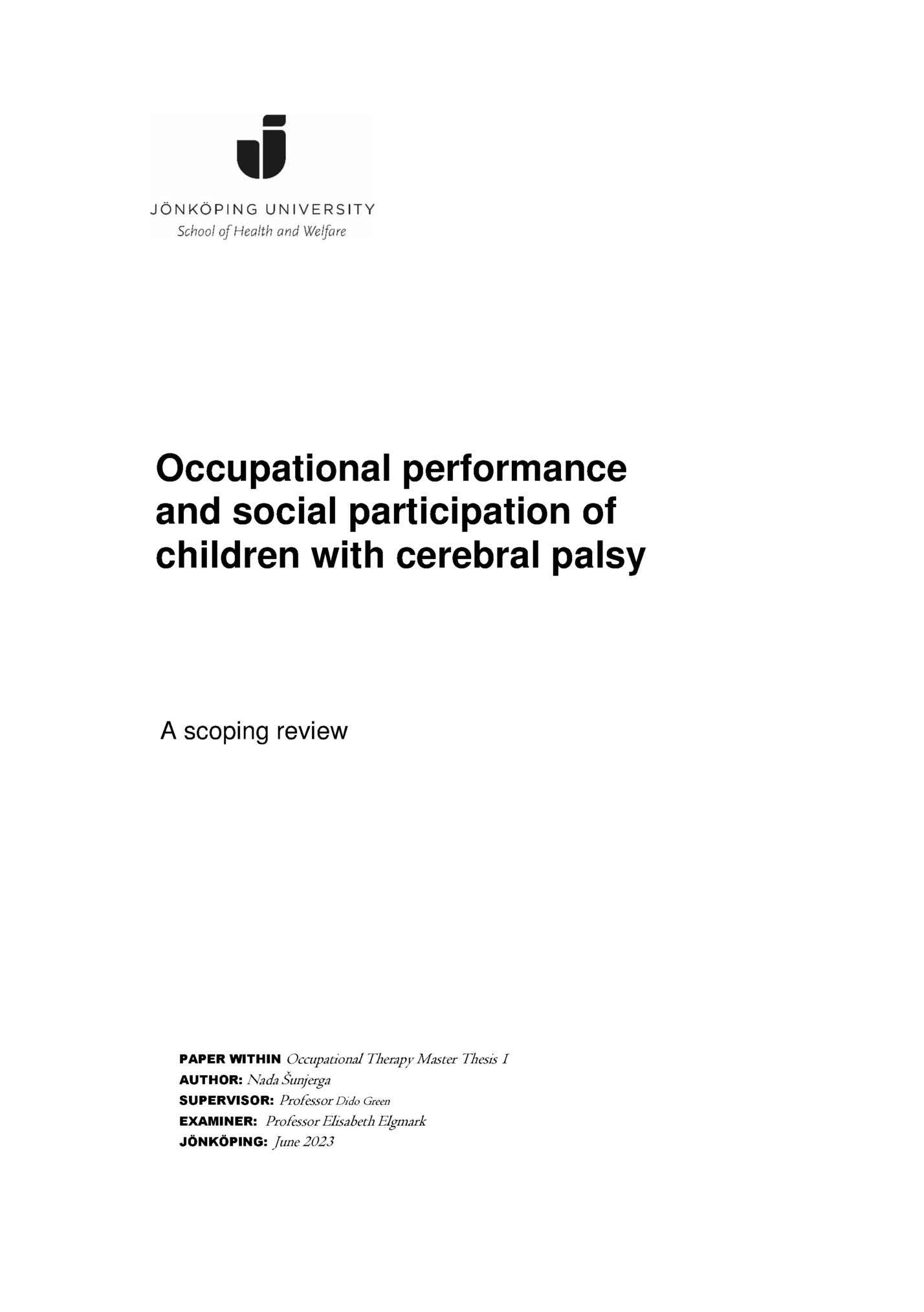
Occupational performance and social participation of children with cerebral palsy A scoping review Running headline: Social participation of children with CP Author: Nada Šunjerga E-mail: suna20bh@student.ju.se Acknowledgment I would like to express my deepest appreciation to my mentor who provided me with professional guidance and shared knowledge and experiences with me. I would also like to thank my mentor for her patience and feedback during the entire thesis writing process. Thanks should also go to all Jönköping University professors who shared their knowledge during various courses and colleagues with whom I exchanged experiences while writing the thesis. I am also grateful to my mother and my boyfriend for their immense support and understanding during this process. Their motivation and belief in me kept me going. Without them, nothing would be possible.

Abstract Introduction: Social participation (SP) of children with cerebral palsy (CP) may be limited by various factors. Domains of occupational therapy were within the Person-EnvironmentOccupation-Performance (PEOP) model. Aim: The study aim was to identify the literature regarding the impact of occupational performance on the social participation of children with cerebral palsy. Method: A scoping review explored peer-reviewed and grey literature from 2013-2023 to incorporate data/experiences via search databases, internet search engines blogs/websites, and manual searches. The inclusion criteria were participants with CP aged 10-18. Data analysis was carried out through qualitative content analysis. Findings: Twenty-nine articles and 14 blogs/websites were included. The impairment's severity and environmental factors emphasizing the parental role and income were prominent influences on OP and SP. The importance of social support was highlighted through experiences presented in grey literature. The themes aligned with the categories of the PEOP model, where a mismatched category occurred, related to sexuality. Conclusion: This review pointed out the factors that influence OP and SP presented based on the categories of the PEOP model, including the mismatched category. Significance: The importance of the representative role of occupational therapy was emphasized. The results indicated future research recommendations based on school type and sexuality. Keywords Cerebral palsy; occupational therapy; person-environment-occupation-performance model; social involvement
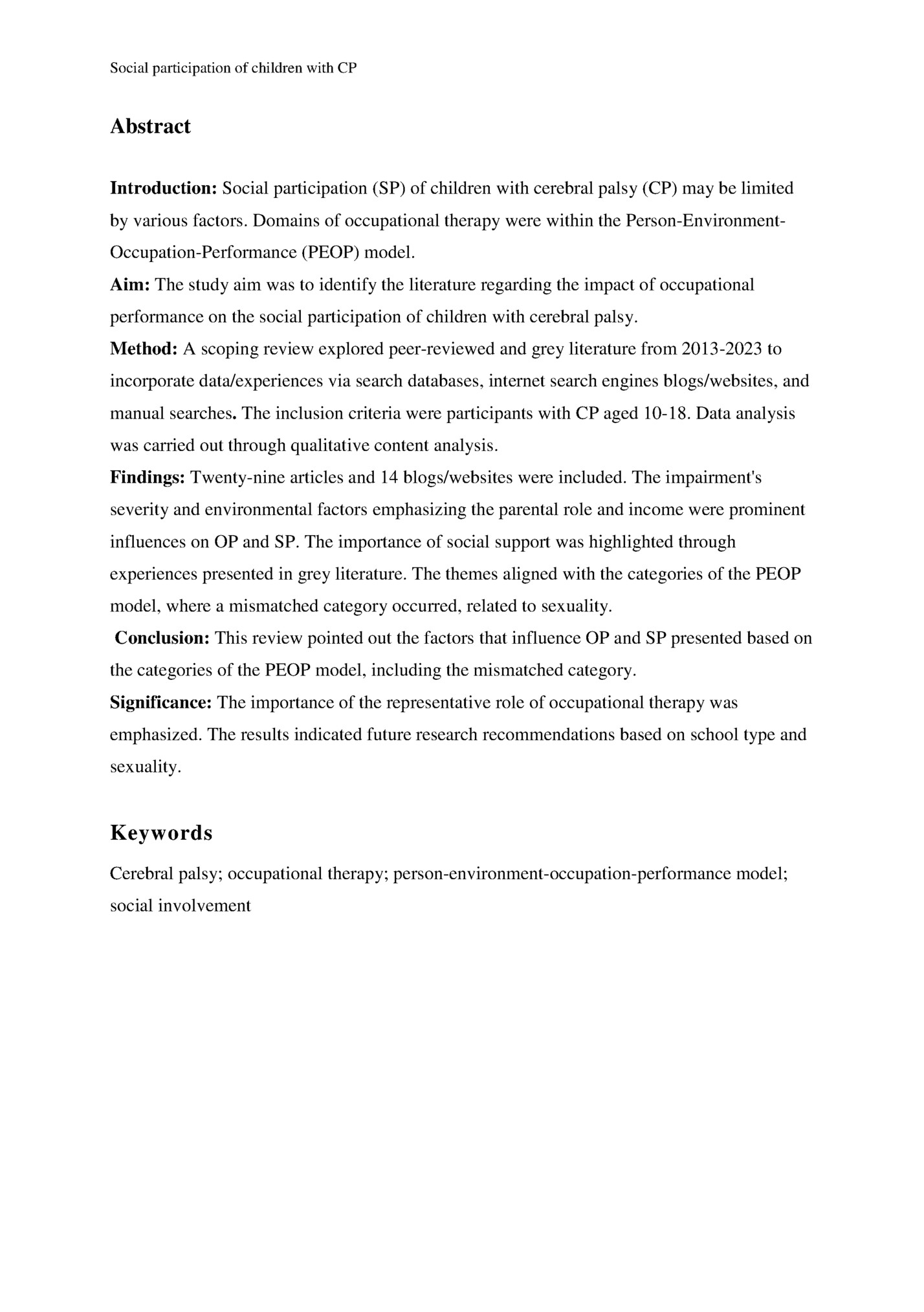
List of abbrevations Abbrevation Definition ADL Activities of daily living AOTA American Occupational Therapy Association CFCS The Communication Function Classification System CP Cerebral palsy GMFCS the Gross Motor Function Classification System JBI the Joanna Briggs Institute MACS Manual Ability Classification System OP Occupational performance OT Occupational therapy OTPF Occupational Therapy Practice Framework PCC Population, Concept, Context framework PEOP Person-Environment-Occupation-Performance Model PRISMA-ScR Preferred Reporting Items for Systematic reviews and Meta-Analyses extension for Scoping Reviews SP Social participation WHO the World Health Organization

Introduction The definition of cerebral palsy (CP) described CP as a group of difficulties in developing movement and stability that cause limited activity (Rosenbaum et al., 2006). Commonly occurring associated symptoms included sensory impairments and perceptual, cognitive, communicative, and behavioural symptoms (Rosenbaum et al., 2006). Children with CP had a higher risk of psychosocial issues and peer problems (Bjorgaas et al., 2013). The psychosocial outcomes depended on the support and surrounding systems, including families, schools, social services and government policies (Rudebeck, 2020). Factors influencing psychosocial status included intellectual impairment and self-esteem, which were associated with peer problems, poor prosocial skills, and hyperactivity (Parkes et al., 2009). These additional factors affected daily life activities, access to education, social relationships, and participation in leisure activities (Rudebeck, 2020). Social participation (SP) in children was crucial for the transition from the home environment to the community and school (Sahoo et al., 2017). Parents, caregivers or service providers played a central role in children's participation (WHO, 2001). Parenting of children with disabilities could lead to stress and isolation of parents, which affected the child's poor mental health (Parkes et al., 2009). The basis for children's social development was the relationship with their parents (Olson, 2010). Seven areas affected a child's social functioning: temperament adaptation, emotional regulation, family habits, family routines, environmental support, participation within the school and, an environment that enables peer interaction and participation (Olson, 2010). The context SP included family, community, peers, and friends (Sahoo et al., 2017). SP depended on physical mobility, communication, understanding the context of social purpose and emotional stability (Sahoo et al., 2017). Difficulties in achieving SP in children with CP might be due to impairments in motor and cognitive aspects (Sahoo et al., 2017). Functional limitations have been associated with reduced performance in self-care activities, mobility and social functioning (Sahoo et al., 2017). Social involvement in children was critical to promoting development, health and well-being (Sahoo et al., 2017). Quality of life and well-being were the outcomes of occupational therapy (OT), and occupation and participation were the basis for achieving these goals (Pizzi, 2017). SP belonged to the domain of OT practice and included engagement in structuring the activities of everyday life, leisure, sports, work, and education (AOTA, 2020). Domains of OT had equal values and impact on quality of life, health and participation in life, and included; occupation, client factors, performance, context, and environment (AOTA, 2020).
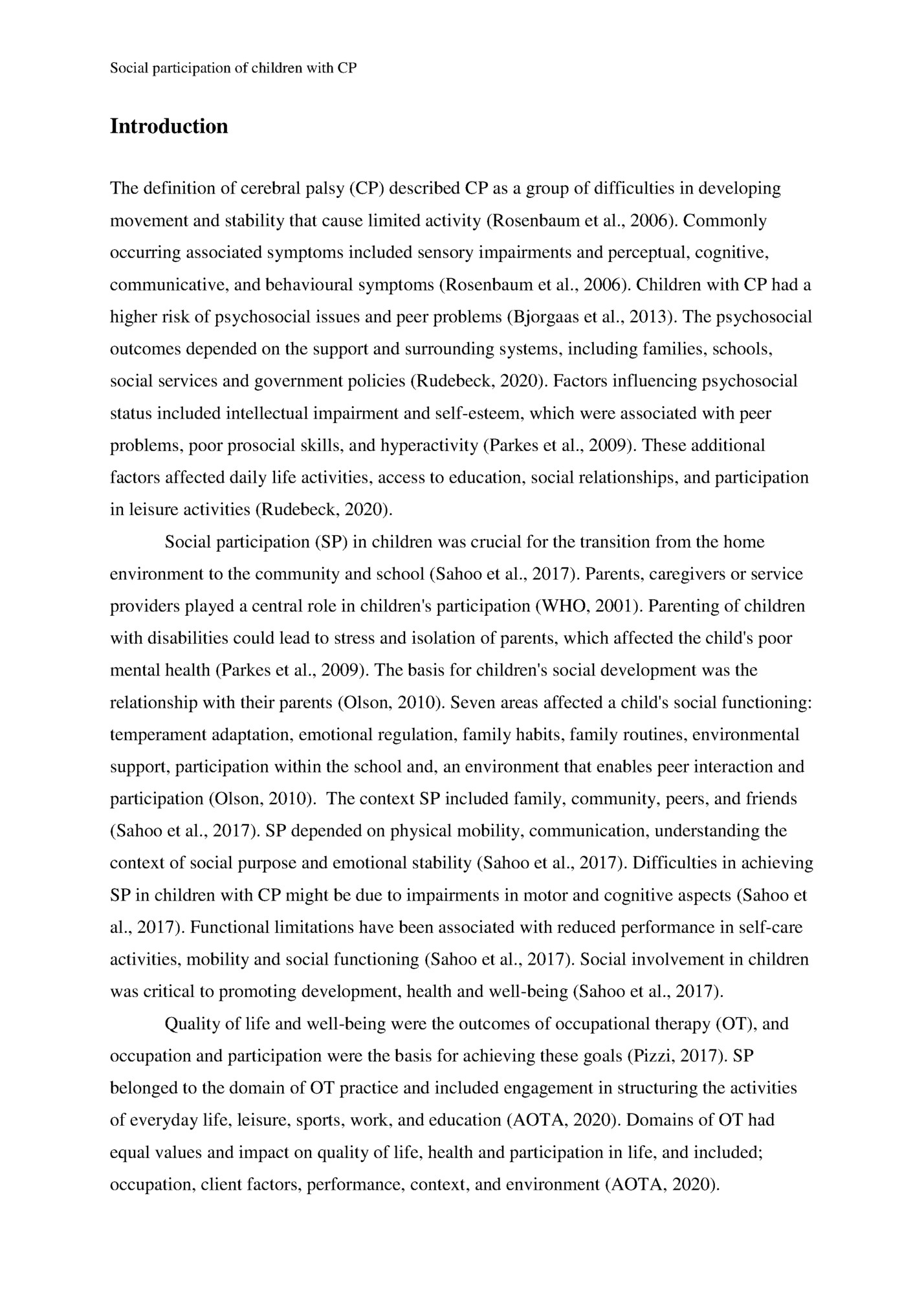
Occupational performance (OP) was the performance of significant activities, tasks and roles through the complexity of the relationship between the person and the environment (Hinojosa et al., 2017). OP enabled the individual to express himself through activities and participate in the activities of everyday life, increasing the quality of life (Hinojosa et al., 2017). OP and participation were the basis for implementing OT intervention strategies of the PersonEnvironment-Occupation-Performance (PEOP) model (Hinojosa et al., 2017). The PEOP model was a client-centred model emphasizing OP (Baum et al., 2015). The PEOP model included four domains that had specific characteristics (Law et al., 1996). The person's domain included roles, personality, physical, cognitive, and sensory abilities, selfconcept, health, and cultural background (Law et al., 1996). The next was the environment, which included a wider perspective on the environment and referred to the social, physical, socioeconomic, and institutional environment (Law et al., 1996). The occupation was described as a domain that referred to the tasks that an individual engages in and expresses himself/herself (Law et al., 1996). Lastly, OP emphasized the characteristics of the person and features of the environment with an emphasized on social support and social determinants (Law et al., 1996). Characteristics of a person included body structures that involve physiological characteristics, body functions that include motor, cognitive, perceptual, sensory, and psychosocial functions, and values and spirituality (Occupational therapy practice framework, 2020). The PEOP model emphasized the relationship between a person and environmental factors that positively or negatively affect OP (Baum et al., 2015). It was considered when the relationship between the person and environment was established during performing occupation, harmony was achieved in the OP, resulting in participation (Baum et al., 2015). The goal of OT through the PEOP model was to achieve purposeful OP, the product of which was participation and well-being (Hinojosa et al., 2017). Previous research has highlighted influences on participation in children with CP considering social and emotional factors (Green et al., 2018), environmental factors (Mihaylov et al., 2004), and participation in leisure activities (Vila-Nova et al., 2020). Therefore, this research focused on the OP of children with CP affecting SP in different settings and gaining insight into different perspectives regarding the OP and participation of children with CP.
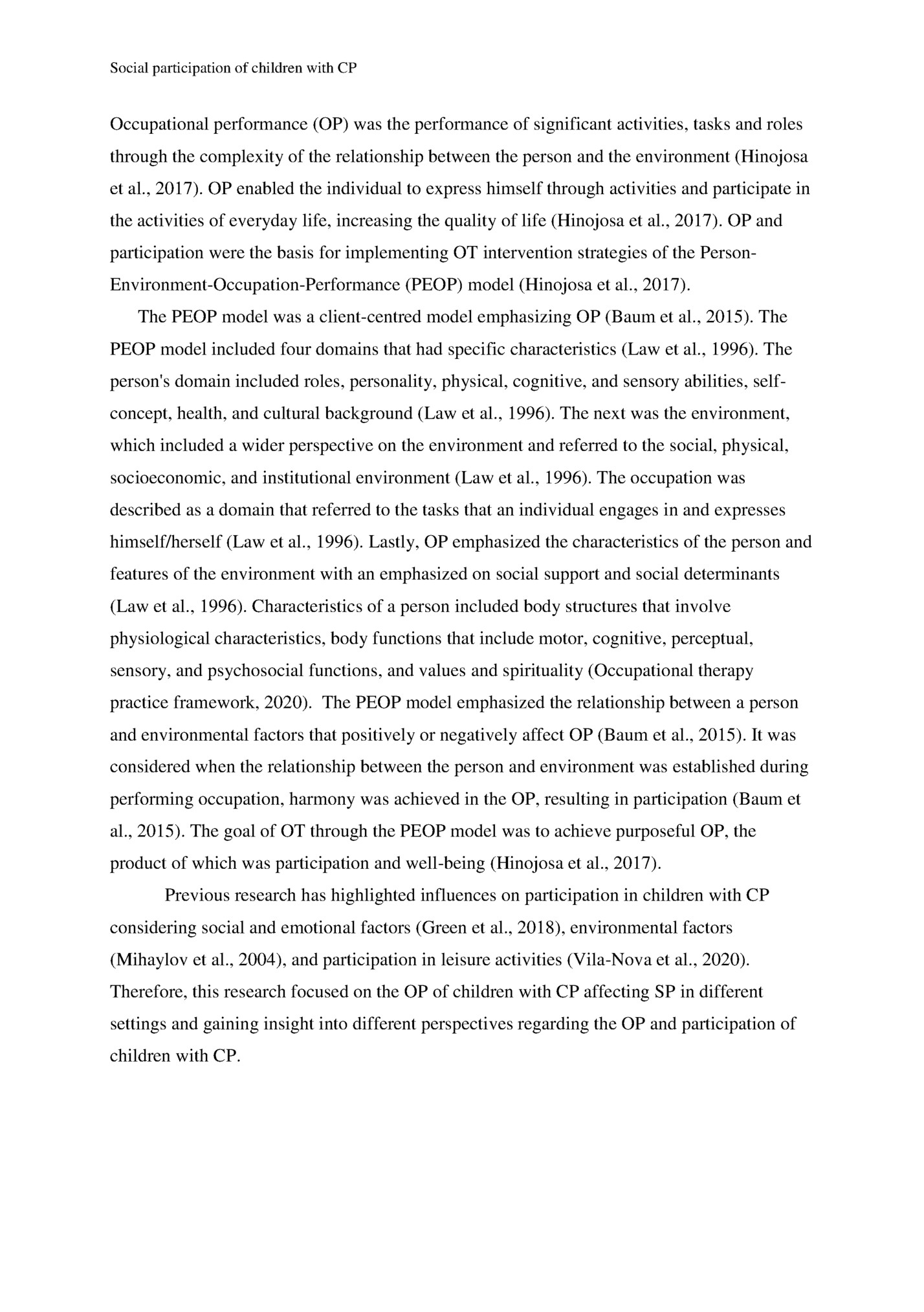
Aim The study aim was to identify the literature regarding the impact of occupational performance on the social participation of children with cerebral palsy. Method The scoping review aimed to examine the scope of research activity, summarize and expand research results, and identify research gaps in the existing literature (Arksey & O’Malley, 2005). To understand the potential impacts of OP on SP a scoping review with qualitative content analysis was used. The scoping review was guided by the methodology of Arksey and O'Malley (2005) and Levac et al. (2010). The improved methodology of scoping review by the Joanna Briggs Institute (2015) and Peters et al. (2021) was also used to research the literature, answer the question posed, and ensure the integrity of the scoping review. The scoping review aimed at a comprehensive literature review (Peters et al., 2021). It included multiple sources of evidence (Peters et al., 2021). Therefore, empirical evidence and nonempirical evidence, such as grey literature consisting of internet media and policy documents, were included in the study (Peters et al., 2021; Adams et al., 2016). Gray literature referred to publicly available sources that commercial publishing organizations, such as nonconventional literature, non-book material, and unpublished documents, did not control (Adams et al., 2016; Schöpfel, 2011). On the other side, "grey data" referred to user-generated web content, a less formal form of "grey literature" used in scoping reviews to obtain a wider range of information (Adams et al., 2016). For this research, a deductive approach was used based on a general search for theories and studies to specify and obtain an answer to the research question (Sheppard, 2020). This form of approach was designed in such a way that it would be associated with a scoping review (Sheppard, 2020). This research used the Preferred Reporting Items for Systematic reviews and Meta-Analyses extension for Scoping Reviews (PRISMA - ScR) to enhance the value and quality of the scoping review (Tricco et al., 2018). Qualitative content analysis was used to present the textual context of the used sources (Hsieh & Shannon, 2005). Based on the application of the deductive approach, the use of directed content analysis enabled composing the meaningful and condensend units with the categories of the PEOP model to develop themes that represent research findings.
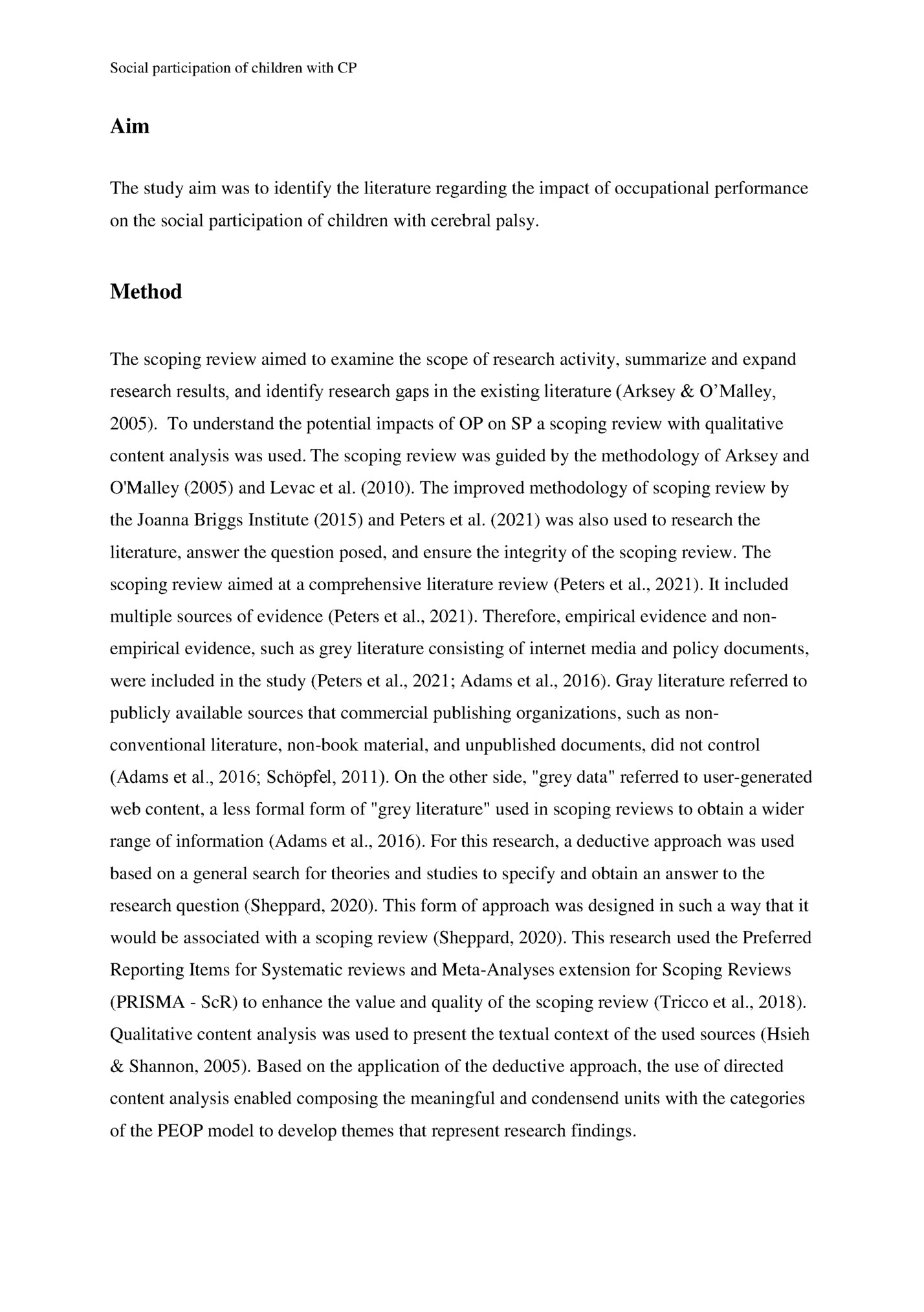
Stage 1: Identifying the research question The scoping review's question was formulated using the Population, Concept, Context (PCC) framework (the Joanna Briggs Institute, 2015) to covered a more comprehensive review than a traditional review based on predetermined criteria, concepts, contexts and problem areas (Peters et al., 2021). Based on the aim of the study, the review intended to answer the following question: 1. What are the associations between the occupational performance of children with CP and social participation? Stage 2: Identifying relevant studies The search strategy in a scoping review should be comprehensive to include published and unpublished literature with a source of evidence (Lockwood et al., 2019, Adams et al., 2016) and set out in detail to achieve precise and transparent reporting (the Joanna Briggs Institute, 2015). Sources included databases, gray literature for publicly available open sources such as blogs/websites, and manual searches (Lockwood et al., 2019). CINAHL, PubMed, PsychInfo, and Scopus databases were searched using keywords selected based on the research question. Boolean operators „AND“ and „OR“ were used as a research, such as „Cerebral palsy OR CP AND Child* OR Adolescent*.” The limits used during the database search were the English language, last ten years of publication and population aged 10-18. Sources for grey literature and grey data included internet search engines, and websites of relevant organizations, including charitable organizations focused on social inclusion. Search methods were adapted to information system trends and different forms of media, including blogs, organizations, and social media (Adams et al., 2016; Schöpfel, 2011). Search terms included associations, charities, and organizations naming CP. The language used when searching websites/blogs was a vocabulary that teenagers used to get broadened when researching. A manual search was also used to include published articles, such as systematic reviews, to get a broader picture. Table 1 presents search terms based on the PCC framework. The researcher carried out the search strategy in agreement with the mentor during supervision, meeting with a librarian, and with the advice of colleagues during peer coaching.

Stage 3: Study selection The included criteria were used to clarify the research concept and the reason for including relevant data (Daudt et al., 2013). Inclusion criteria included children from 10 to 18 years old diagnosed with CP. The reason for including children aged 10 to 18 was to capture the broader aspect of SP outside school and home, including other elements such as work, romantic relationships, and leisure activities when children are becoming more independent in organizing their social activities (Lopes et al., 2019). Articles and websites/blogs were included if they focus on participation within the school and community. The inclusion of articles was based on reports freely publicly available in English and available from 2013. (See Table 2 for summary). Figure 1 summed up the process of literature selection, screening of duplicates, exclusion of studies based on the included criteria, and final section of studies. Stage 4: Charting the data The screening process was carried out using the PRISMA-ScR (Tricco et al., 2018). The researcher independently extracted the included studies’ data under the mentor’s supervision. Table 3a presents an overview of the database and manual search that provides the number of hits, the number after duplicates were removed, chosen articles by title and abstracts, and selected articles by type of study. Table 3b presents an overview of websites/blog searches that includes the reason for inclusion based on name, tabs/information matching the context, and chosen by context and lists the information provided within the website/blog. A datacharting form determined whether data extraction was in accordance with the research question (Peters et al., 2015). Table 4a presents data extracted from databases which included: the author, the title, the year of publication, the country where it was conducted, study design, characteristics of selected participants, the aim of the study, measures, and results, precise impact and experiences of OP on SP (Peters et al., 2015). Table 4b presents data extracted from websites/blogs included: the topic, the author, the publication content year, the country, organization or type of website/blog, target users, the aim or activities for managing the impact of OP on SP, and the impact of OP/experiences on SP. (Tables presented in Appendix)
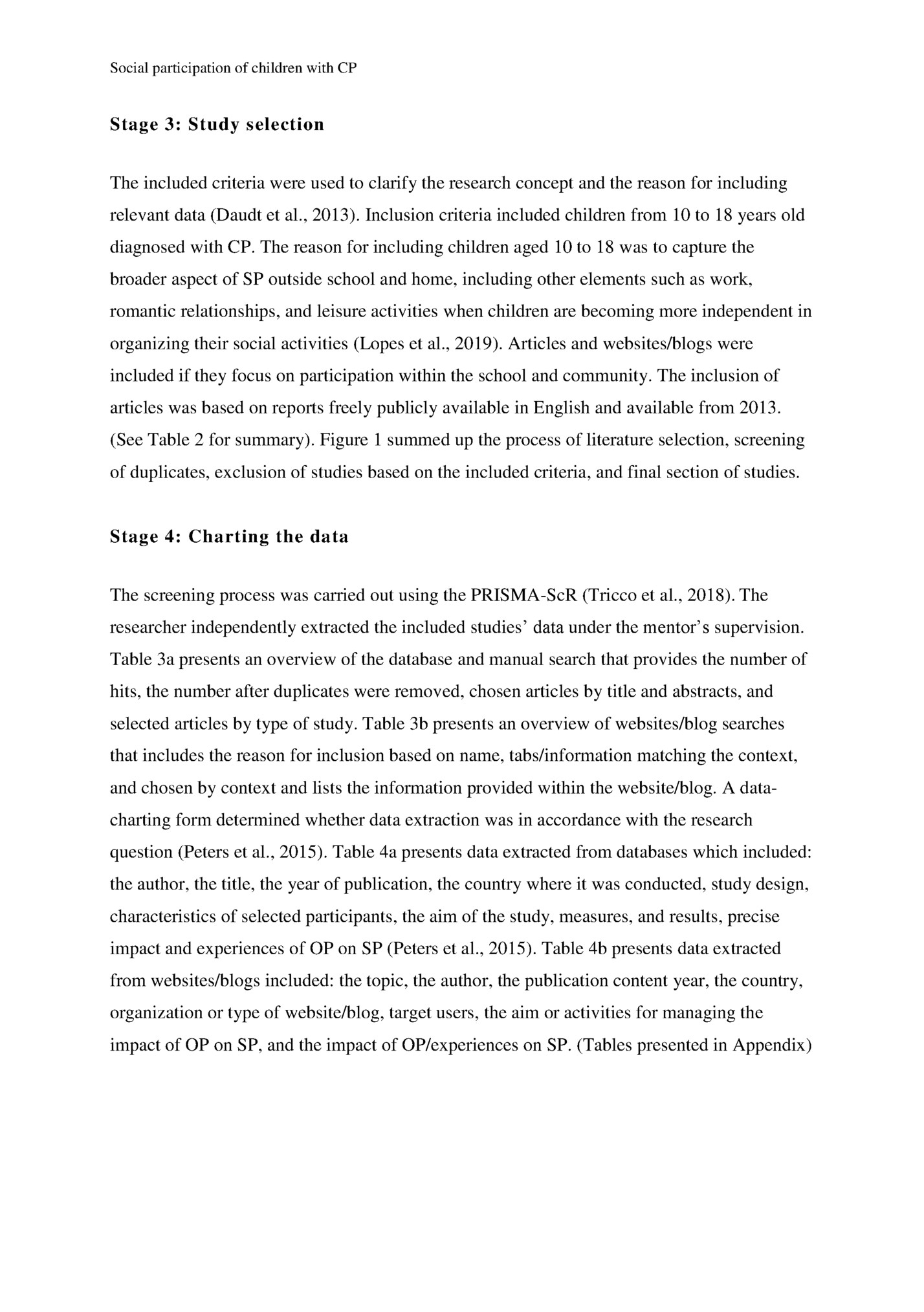
Fleepit Digital © 2021